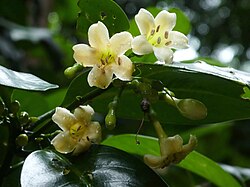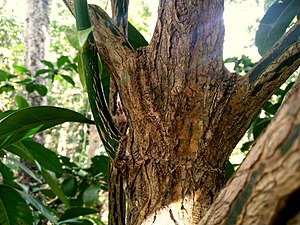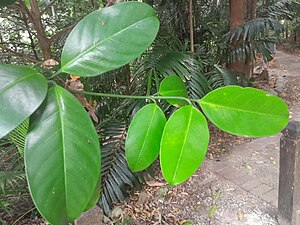Biology:Fagraea cambagei
| Porcelain fruit | |
|---|---|

| |
| In flower at the Cairns Botanic Gardens | |
Script error: No such module "Conservation status".
| |
| Scientific classification | |
| Kingdom: | Plantae |
| Clade: | Tracheophytes |
| Clade: | Angiosperms |
| Clade: | Eudicots |
| Clade: | Asterids |
| Order: | Gentianales |
| Family: | Gentianaceae |
| Genus: | Fagraea |
| Species: | F. cambagei
|
| Binomial name | |
| Fagraea cambagei | |
Fagraea cambagei, commonly known as porcelain fruit, pink jitta, or yellowheart,[3] is a plant in the family Gentianaceae which is endemic to rainforested parts of coastal northeast Queensland, Australia.
Description
This is an evergreen tree growing up to 20 m (66 ft) in height,[4][5] and the trunk of the tree is often marked with a plaited or woven pattern (see gallery).[6] The leaves are simple (i.e., without lobes or divisions) with an opposite arrangement. They are held on thick petioles (stems) measuring between 2 and 3.5 cm (0.79 and 1.38 in) long, they are elliptic to obovate in outline, and they measure up to 23 by 9 cm (9.1 by 3.5 in).[4][5][6]
The inflorescence is a terminal panicle with up to 30 fragrant bell-shaped flowers.[4][5][6] They measure up to 5 cm (2.0 in) long with five cream-coloured petals, and may occur at any time of year.[5] The fruit is, in botanical terms, a berry up to 3.5 by 4.5 cm (1.4 by 1.8 in), white, pink or red and with a shiny appearance that gives rise to the common name "porcelain fruit".[4][5][6] They may or may not contain seeds, which are about 7 mm (0.28 in) long.[4][5][6]
Taxonomy
Fagraea cambagei was first described in 1928 by the Czech botanist Karel Domin, and published in the journal Bibliotheca Botanica.[1][2] Up until early 2023, Plants of the World Online had misapplied the name Fagraea gracilipes to this species.[6][5]
Etymology
The genus name Fagraea was coined by Carl Peter Thunberg in honour of the botanist and physician Jonas Theodor Fagraeus.[5] Domin created the species epithet cambagei in honour of the Australian botanist and surveyor Richard Hind Cambage.[5]
Distribution and habitat
The porcelain fruit grows as an understory tree in well developed coastal or sub-coastal rainforest, often in very waterlogged habitats such as swamps and close to creeks. Its range extends from near Rossville south to the area around Innisfail, and from sea level to 500 m (1,600 ft).[4][5][6]
Conservation
This species is listed by the Queensland Department of Environment and Science as least concern.[3] (As of May 2023), it has not been assessed by the International Union for Conservation of Nature (IUCN).
Gallery
References
- ↑ 1.0 1.1 "Fagraea cambagei". Centre for Australian National Biodiversity Research, Australian Government. https://id.biodiversity.org.au/name/apni/60723.
- ↑ 2.0 2.1 "Fagraea cambagei Domin". Royal Botanic Gardens, Kew. https://powo.science.kew.org/taxon/urn:lsid:ipni.org:names:546109-1.
- ↑ 3.0 3.1 "Species profile—Fagraea cambagei". Queensland Government. 2022. https://apps.des.qld.gov.au/species-search/details/?id=8128.
- ↑ 4.0 4.1 4.2 4.3 4.4 4.5 Conn, B.J.; Brown, E.A. (2022). "Fagraea cambagei". Australian Biological Resources Study, Department of Climate Change, the Environment and Water: Canberra. https://profiles.ala.org.au/opus/foa/profile/Fagraea%20cambagei.
- ↑ 5.0 5.1 5.2 5.3 5.4 5.5 5.6 5.7 5.8 5.9 Cooper, Wendy; Cooper, William T. (June 2004). Fruits of the Australian Tropical Rainforest. Clifton Hill, Victoria, Australia: Nokomis Editions. p. 222. ISBN 9780958174213. https://www.nokomis.com.au/product/nokomis-published-books/fruits-australian-tropical-rainforest/.
- ↑ 6.0 6.1 6.2 6.3 6.4 6.5 6.6 "Fagraea cambagei". Centre for Australian National Biodiversity Research (CANBR), Australian Government. 2020. https://apps.lucidcentral.org/rainforest/text/entities/Fagraea_cambagei.htm.
External links
- View a map of historical sightings of this species at the Australasian Virtual Herbarium
- View images of this species on Flickriver
Wikidata ☰ Q65938663 entry
 |






